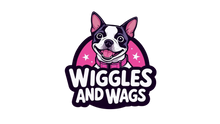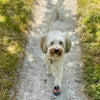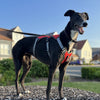What Is a No Pull Dog Harness

What type of no pull harness is best for my dog?
There are various designs and some of the most popular fall into one of three categories.1. A full padded harness
A harness with padding will suit most breeds, especially those with little fur or those that are super active. Dogs with a thick coat can also use them as the level of adjustment is usually very good. The extra cushioning can provide extra support and a good quality harness should soften any pulling forces from a lead. Many will contain soft padding around the edges which covers harsh straps and prevents chafing or rubbing on legs as the dog walks.
2. A strap version
A strap only version can be very similar in design to the padded harness but without the padding. Instead, there are a series of straps around the neck, torso, rib cage and even the rear and lower back. If you buy a strap only harness, make sure it is fitted well and does not sit in the crease or arm pit of your dog. It should also fit quite snugly so that any sideways movement does not rub on the dog's fur or skin.
3. A three-strap version (with or without padding)
A harness with three straps includes an extra rear strap which sits at the bottom of your dog's back and secured around the girth. This can offer more support for active dogs and for those that do Canicross or run with their owners. This design is also useful when it comes to stopping dogs from escaping. As the rear strap is so far back it is almost impossible for a dog to back out of a harness like this.
Depending on the size and breed of your dog, you should use a style which fits around the key parts of your dog's body and offers support. The harness should not rub on the legs or impede shoulder movement.
If you have a dog with a very large chest, long neck or is an awkward size, it is even more important to measure your dog and match those measurements to the ones shown on the web store's website. In many cases it is better to go up a size and have it on a smaller setting than to order a smaller size and have the straps adjusted to the largest setting.
When sizing, one area to pay particular attention to is the strap that sits just behind the dog's front legs. You should allow for a gap of at least 1 inch or 2.5 cms between the front legs and any strap that goes around the rib cage or upper torso.
What are the main differences between a normal harness and a no pull dog harness?
A no pull harness will look very similar to a normal harness but in addition to a lead attachment point on the top of your dog's shoulders or back, it will also have an attachment point either around your dog's chest area, or somewhere around the lower neck or nose. The front ring on a no pull harness can be used to apply steering forces and the top ring is used as a brake.With a standard harness, you simply attach a lead to the top clip at the top of the dog's back. With a no pull harness, you can attach a standard lead to the front clip or use a double ended training lead and attach each end to the top and front clip.
How Do The attachment rings on a no pull harness work?
You can choose to attach a normal lead (with a clip at one end) to the top or front attachment points on the harness, but to get the most out of the harness, you may want to use a training aid like a double ended dog lead. This type of lead has a clip at both ends - you simply attach one end to the ring on the top of the harness and the other end to the ring on the front of the harness. A training lead will often be up to 2.5 metres in length and has many uses in addition to those used in conjunction with a no pull dog harness. These can include being used to tether your dog, as a hands free walking aid or even to walk two dogs.
When you attach one end of a double clip lead to the front of the harness, you have created a steering aid which can throw your dog off from going forward. As your dog pulls forward, you can simply steer your dog off course by applying a steering motion to the lead attached to the front clip. Alternatively, when the lead goes taut, this can automatically move your dog to one side in a gently way. The other end of the double ended lead is attached to the top clip and this will act as a brake. These type of leads can be a useful training aid when used with a no pull harness. If you reinforce good behaviour with voice commands and treats (when the dog is walking nicely) this should speed up the training process.
What is the best harness to stop my dog from pulling?
This depends on the type of dog, the size and shape of it and how you are going to apply and use any training aids.For most dog breeds, a strap only or padded harness will work well, but it is important that you understand that no pull dog harnesses are not a miracle cure and should be used as a training aid. If you apply good training techniques and voice commands, as well as praise and rewards, you should see very positive results. A good quality harness should also last you for many years to come, even when your dog is walking nicely by your side!
Will a no pull dog harness hurt my dog?
No, a well designed, comfortable no pull harness should not cause your dog any discomfort at all. Just make sure that any movements or forces applied to the lead are gentle and not aggressive in any way.Are no pull harnesses easy to fit?
Yes, harnesses of this design are very easy to fit and use. With most designs, you'll put the front part over your dog's head and secure it around the belly and lower neck. They can then be unclipped and removed in seconds. Some manufacturers also have quick release clips on the neck, in case your dog is sensitive to things going over its head.Could a no pull harness make our dog walk less enjoyable?
A harness of this type should not interfere with your dog walk in any way or make it any less enjoyable for either dog or owner. Think of the harness as a training aid to develop good walking behaviour and then as a long-term valued accessory when your dog is walking well.Always check that the harness is fitted correctly and that you have chosen the right size for your dog's breed and size. Sometimes, a harness that is not fitted correctly or one that is not fit for purpose will cause some discomfort, especially, if legs rub on straps or areas of the torso are covered to restrict movement. Always check the sizing of the harness and make sure that you measure your dog accurately before ordering. If your dog is at the top of the size scale, it is probably best to go up a size.
If you are buying the product from a reputable company they should have a sales hotline number. Just call them for advice and see if they are knowledgeable about the products they stock.
Is an anti-pull dog harness and a no pull dog harness the same thing?
Yes, they are both classed as devices or walking accessories to help promote good walking behaviour. They just use different terminology so 'anti pull' and 'no pull' means a device that is designed to aid your walking experience and to help stop pulling for good.If you would like to see some of these products in action please see our front clip dog harness range here.





